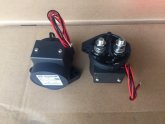Yeah, I picked up a used TE Contactor for $30 off of eBay. The coil appears to draw about 2 watts when energized at nominal 24V and does not get warm at all when it is energized for hours at a time. Unfortunately, I'm still waiting on my batteries (8-280ah LiFePo4), so I have only been able to run about 3 amps through the main contactor from a bench power supply. I can't speak to how warm they will get under actual load conditions, but they are rated for 500A and I'll probably max it out at about 125A at 24V. I can say that they are much better than the relays that you can get from Chargery. Those suckers got too hot to touch just energizing the coil and drew about 11 watts. I started out with two 12V Chargery relays directly fed from the Chargery BMS 12V outputs, then figured out that if I use the output of two small SSRs in series with the TE Contactor coil, I only have to use one main contactor instead of two and not worry about overloading the Chargery BMS outputs. This cuts down the potential wasted energy from about 528 watt-hours per day to 48 watt-hours per day. An added benefit of the TE Contactor is that the coil can be driven with 24V, so it makes wiring the coil circuit pretty simple. I paid $13 each for the two SSRs at the following link: https://www.amazon.com/gp/product/B079BGGVYX/ref=ppx_yo_dt_b_asin_title_o08_s00?ie=UTF8&psc=1
Do those SSRs require a separate 12V supply of power, or are they activated directly through the leads from the BMS?







